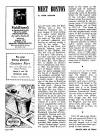
Home Page Meet Boston Menu Index
|
MEET BOSTON Friday, February 13, 1942 in What's New In Town W. J. Sidis |
Way back when the Back Bay was a bay, its Brookline headland was a long tongue of land coming to a point called Sewall’s Point. It was very much on the order of “the other end of nowhere”―deserted, and leading to nothing except a view of the water. Two trails led to the Point, one towards Newton, past the banks of the Charles, one into the hills of Brooklne. In the early 19th century, a mill-dam was built, for tidal power, across the mouth of the Back Bay, from Beacon Hill in Boston to Sewall’s Point in Brookline; and, when, in 1821, the Mill-Dam (now part of Beacon Street) was open for public passage over the top of it, Sewall’s Point was suddenly converted from a deserted country shore into a traffic center. An extension of the dam to Brookline Village added to the traffic at that point. During the course of the 19th century, the Back Bay was filled in completely, and the Legislature shifted the boundaries of Brookline so as to give the former Sewall’s Point to Boston. It was now a crossroads instead of a point of land, and it acquired the name of Governor’s Square, where Beacon Street came to its junction with the Newton Boulevard (now part of Commonwealth Avenue and with the old dam extension to Brookline Village (Brookline Avenue). The city’s contract provided that access should “remain forever open” across the square from Beacon Street to the street on the railroad side of Commonwealth Avenue, which received the name of Kenmore Street, for the original name of the mill-dam company. Access across the square was, however, blocked by the entrance ramp of the Boylston Street Subway, set up there in 1912-14. The name of Kenmore became associated with the neighborhood, as the name of the car-stop at the subway entrance. In 1932, when the station of “Kenmore” was put underground, it became possible to restore public access across the square―now renamed Kenmore Square for the subway into the square to meet the station. And, in 1934, when several bus lines were brought into the square to meet the subway, Kenmore Square became one of Boston’s important centers.
*
A peculiarity of the Charlestown Bridge is that, near the Boston end, it makes a sudden bend. The bridge, before 1900, was straight, and was a continuation of Prince Street in the North End. It may also be noted that it is at Prince Street that Causeway Street becomes Commercial Street, yet now there is nothing special to mark that corner. This bridge was the first bridge over the Charles below Brighton, and was built some ninety years ago. City Square was set up then, as a bridge plaza.
*
Until 25 years ago, Brookline was governed directly by meetings
of its citizens. It was the largest unit in the world to have even been governed
in that manner.